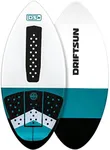Buying Guide for the Best Fiberglass Skimboards
Choosing the right fiberglass skimboard can greatly enhance your experience on the water. Skimboarding is a fun and exciting sport, but having the right board can make all the difference in your performance and enjoyment. When selecting a fiberglass skimboard, it's important to consider several key specifications that will affect how the board handles, its durability, and how well it suits your skill level and riding style. Here are the key specs to consider and how to navigate them to find the best fit for you.SizeThe size of a skimboard is crucial because it affects your ability to control the board and perform tricks. Skimboards come in various sizes, typically measured in inches. Smaller boards (under 45 inches) are more maneuverable and better for tricks, making them ideal for lighter riders or those who prioritize agility. Medium-sized boards (45-50 inches) offer a balance between control and stability, suitable for intermediate riders. Larger boards (over 50 inches) provide more stability and are better for heavier riders or those who prefer long, smooth rides. Choose a size that matches your weight and riding style for the best performance.
ShapeThe shape of a skimboard influences how it rides on the water. There are two main shapes: traditional and hybrid. Traditional shapes have a more pointed nose and are designed for speed and distance, making them great for flatland skimboarding. Hybrid shapes have a wider nose and tail, offering better control and maneuverability, which is ideal for wave riding. Consider where you will be skimboarding most often and choose a shape that suits those conditions.
RockerRocker refers to the curvature of the board from nose to tail. A board with more rocker (greater curvature) is easier to maneuver and better for wave riding, as it helps prevent the nose from digging into the water. Boards with less rocker (flatter) are faster on flat water and better for long rides. Beginners might prefer a board with moderate rocker for a balance of speed and control, while more advanced riders can choose based on their specific needs.
ThicknessThe thickness of a skimboard affects its buoyancy and durability. Thicker boards (around 5/8 inch) are more buoyant and durable, making them suitable for beginners and heavier riders. Thinner boards (around 3/8 inch) are lighter and more responsive, preferred by advanced riders who want to perform tricks. Consider your skill level and weight when choosing the thickness of your board.
MaterialFiberglass skimboards are known for their durability and performance. The fiberglass layer provides strength and a smooth finish, while the core material (usually foam or wood) affects the board's weight and flexibility. Foam cores are lighter and more buoyant, making them easier to handle for beginners. Wood cores are heavier but offer more control and are preferred by experienced riders. Choose a material that matches your skill level and the type of skimboarding you plan to do.
TractionTraction pads or grip are essential for maintaining control of your skimboard. Some boards come with built-in traction pads, while others require you to add them separately. Good traction helps prevent slipping and allows for better maneuverability. If you're a beginner, look for a board with a comfortable and effective traction pad. Advanced riders might prefer customizing their grip to suit their specific needs.











